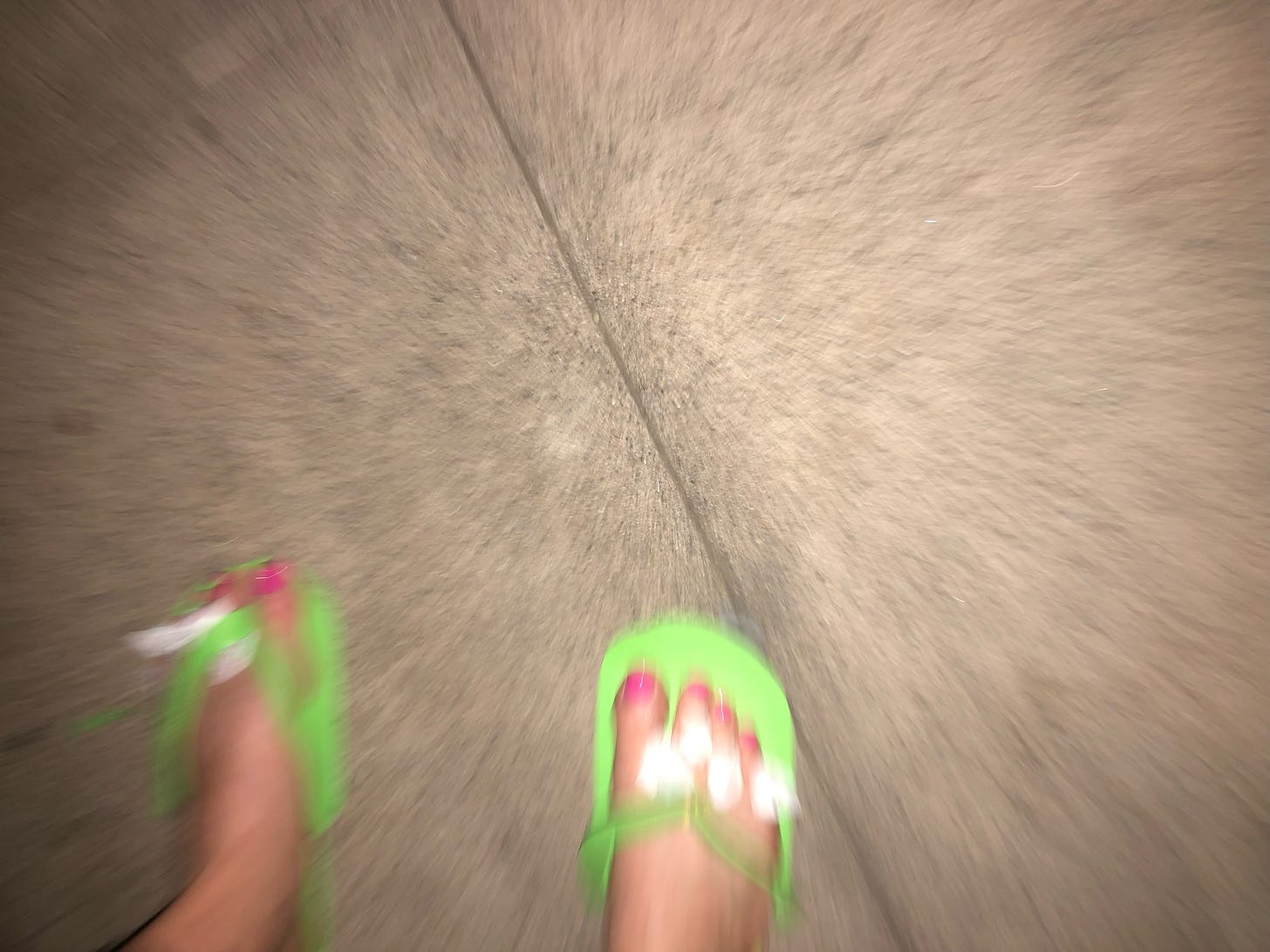When I was a teenager, a group of girls held me down to put makeup on me during a sleepover. The makeup was cheap and made my cheeks burn. I told them to stop, but when five girls are intent on making you “beautiful,” they hold your arms and legs until they’re finished.
I started shaving my legs because a schoolmate told me I was hairy. My legs are like my father’s: sturdy, athletic, and truthfully very hairy, as articulated by my fourth-grade colleague. I have dark, bristly leg hair and pale skin. I don’t bother shaving at all anymore; my hair just grows back the next day. Once in a while, feeling the pressure of a beach day or a wedding, I get my legs waxed. Each time I am chastised. The technician must take a deep breath when they come over to examine me, lying face up on a piece of butcher paper in my underwear. “Wow,” they say with a sigh. “Okay.”
They manage to pull themselves together enough to share with me their professional wisdom, though not without visible distress. They tell me that I really need to consider waxing my legs every two weeks, that I must exfoliate daily, and that I’m a good candidate for laser removal. Overextending the muscles of their face, they talk very slowly so that I will understand. Just verbalizing these statutes exhausts them, however, not to mention the actual work of making me presentable. Afterwards, though clearly relieved by the results of their labor, they always look like they need a nap. Guiltily, I tip them as well as I can.
Hairstylists feel the same way about me. My hair is too fine, too greasy, too many split ends, unmoisturized. The salon has always felt to me more like going to the dentist—a place where procedures are to be endured—all for the sake of being closer to some shadowy ideal of beauty.
Perhaps because I’m bad at it, I’m fascinated by those to whom beauty regimes are a natural, typical, continuous part of their existence. I often witness these types on reality shows, or occasionally portrayed on a docuseries, like America’s Sweethearts, which follows the Dallas Cowboys Cheerleaders, known as the DCC.
“We look like Barbies,” exclaims Charly Barby and Kelly Villares, as they finish putting on the DCC uniform for the first time. Of the hundreds that try out, thirty-six are chosen. Famously, all games open with “Thunderstruck” by AC/DC, a grueling five-minute routine that ends with the dancers jumping into the splits.
“She looks prettier this year,” says Kelli Finglass, the director of the program, commenting on one of the auditioners. She compliments another on her physique in the uniform, stating that “tiny shoulders and tiny torsos always look good.”
I got my period in the early 2000s, when Kate Moss was a perennial cover girl, accompanied by other skeletal models, all considered “effortless” beauties. I never had an eating disorder, but I started to distrust my thighs and my hunger and my body in general after flipping through magazines and reading articles about celebrities whose bodies were “transformed” by pilates, or famous women who would throw water onto their meals to prevent them from eating more.
Aunts and uncles and my parents’ friends commented on my weight as a teenager and into adulthood—especially on whether I had lost or gained weight. A strong sense of praise was associated with the word “skinny.” This was how I apprehended that my body was something separate from me, learned the bifurcation of being versus being seen. Something cheerleaders seem to daily grapple with.
Though the amount the DCC women make is undisclosed, some have confessed to making fifteen dollars an hour. Most of the dancers have two to four other part-time jobs to support themselves amidst the rigor of being cheerleaders.
“But why would we want people to quit their full-time jobs when that’s what’s so impressive about y’all?” asks head choreographer Judy Tramell, when discussing the possibility of a pay increase for the dancers.
“Pressure is a privilege,” quips an auditioning cheerleader about to get cut from the team.
Dallas Cowboys NFL team members are paid up to 55 million dollars per year, and the team itself is valued at over 10 billion. While supposedly a 400% pay increase has been garnered for the cheerleaders next season—likely due in part to recent Netflix fame—the cheerleaders are still without health insurance.
“I definitely didn’t feel supported. I felt like I was just a body,” says KayDianna Garza, who quit the team midseason this past year.
In a society where almost everything is considered a product, women’s bodies are no exception. As a young kid I didn’t think about what it meant to inhabit the body that is mine, to feel at home in myself. It’s a feeling I’m still trying to return to.
While I don’t think there’s anything wrong with wanting to be considered beautiful—whatever that means, across a miscellany of cultures—the cheerleaders, as such, seem no more or less confident than my own hipster friends, with our hairy armpits and tortoiseshell glasses. They are powerful and skilled at their craft, whilst still struggling to know what they want and how to make a difference. Thus, the myth of the cheerleader—the perfect, self-assured woman—remains seemingly unrealized, even amongst the cheerleaders themselves. However one might appear, no life is without effort.
I go to visit my friends and their six month old daughter, who feels everything at once. Squirming grunting smiling crying, she attempts to crawl across their living room, using all of the power she can summon. Instead of being able to crawl, however, she does a plank pose for several minutes, grunting in place.
We look out the window together, at the trees, the blue pastel sky. She smiles and then cries. I pay attention to how I feel as I sit in their house, amidst all their baby things. Wanting needing hurting being. I feel alive.
Citations









So well written— I know I could feel the pain of being in school Again and the pressure to be a certain size. You speak from experience and from the soul and it is so relatable. I hope more woman can grow up feeling connected to themselves.